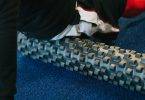Introduction:
Mastering proper form is a crucial aspect of maximizing your gym performance and achieving your fitness goals. Whether you’re a beginner or an experienced gym-goer, understanding and implementing correct form can significantly enhance your workout effectiveness and minimize the risk of injuries. In this article “Mastering Proper Form: Elevate Your Gym Performance and Reap the Benefits”, we will delve into the importance of proper form, outline essential techniques, and highlight the numerous benefits it brings.
- Injury Prevention: Maintaining proper form during exercises helps reduce the risk of injuries, such as strains, sprains, and muscle imbalances.
- Targeted Muscle Engagement: Correct form ensures that the intended muscles are being properly engaged, leading to more effective workouts and desired results.
- Optimal Movement Patterns: Proper form promotes efficient movement patterns, improving overall performance and preventing unnecessary strain on joints and ligaments.
Essential Techniques for Proper Form:
a. Squats:
i. Hip and Knee Alignment: Keep your knees aligned with your toes and maintain a neutral spine.
ii. Depth and Range of Motion: Aim for a comfortable depth while maintaining control and stability.
iii. Core Engagement: Activate your core muscles to support your spine and enhance stability.
b. Deadlifts:
i. Hip Hinge: Initiate the movement by hinging at the hips while maintaining a flat back.
ii. Grip and Hand Placement: Use an overhand or mixed grip and position your hands shoulder-width apart.
iii. Proper Lifting Technique: Engage your glutes and hamstrings to lift the weight, avoiding excessive rounding of the back.
c. Bench Press:
i. Grip Width: Choose a grip width that allows your forearms to be perpendicular to the floor when the barbell is lowered.
ii. Shoulder Blade Retraction: Squeeze your shoulder blades together for stability and to protect your shoulders.
iii. Full Range of Motion: Lower the barbell until it touches your chest and then press it back up fully, extending your arms.
Benefits of Proper Form:
a. Enhanced Muscle Development: Proper form targets specific muscles more effectively, leading to improved muscle growth and strength gains.
b. Increased Efficiency: By performing exercises with correct form, you optimize your movement patterns and energy expenditure, maximizing the efficiency of your workouts.
c. Injury Prevention and Longevity: Maintaining proper form minimizes the risk of injuries, allowing you to train consistently and progress over time.
Common Mistakes to Avoid:
a. Using Momentum: Swinging or using momentum to lift weights diminishes the effectiveness of the exercise and increases the risk of injury. Focus on controlled movements and proper muscle engagement.
b. Rounded Back: Maintaining a rounded back during exercises like deadlifts or rows puts excessive stress on the spine. Keep your back straight and engage your core for stability.
c. Improper Breathing: Neglecting proper breathing techniques can hinder your performance and compromise form. Remember to exhale during the exertion phase and inhale during the eccentric phase of each exercise.
Key Tips for Maintaining Proper Form:
a. Warm-Up: Prioritize a dynamic warm-up routine to prepare your body for exercise and enhance flexibility.
b. Practice Mind-Muscle Connection: Focus on the target muscle group during each exercise, ensuring proper engagement and activation.
c. Use Mirrors or Recording: Utilize mirrors in the gym or record your workouts to assess your form and make necessary adjustments.
d. Seek Professional Guidance: Consider working with a certified personal trainer or strength coach who can provide expert guidance and correct any form issues specific to your needs.
Integrating Proper Form in Your Workout Routine:
a. Start with Bodyweight Exercises: Begin your fitness journey by mastering proper form with bodyweight exercises such as squats, lunges, and push-ups.
b. Gradually Increase Weights: As you develop confidence and proficiency, gradually incorporate weights into your routine while maintaining proper form.
c. Focus on Quality Over Quantity: Emphasize quality repetitions with proper form rather than sacrificing form for the sake of more repetitions. This approach yields better results and reduces the risk of injury.
Tracking Progress and Making Adjustments:
a. Keep a Workout Journal: Maintain a workout journal to track your exercises, weights, and form improvements. This helps you monitor progress and identify areas that need adjustment.
b. Regular Form Check-Ups: Periodically evaluate your form, either through self-assessment or with the assistance of a trainer, to ensure you’re maintaining proper technique and making necessary adjustments.
Tailoring Form to Your Fitness Goals:
a. Strength Training: Focus on proper form to maximize muscle recruitment and strength gains. Gradually increase weights while maintaining form integrity.
b. Endurance Training: Maintain proper form throughout high-repetition exercises to enhance muscular endurance and stamina.
c. Flexibility and Mobility: Incorporate exercises that promote proper form and movement patterns while improving flexibility and mobility.
Overcoming Challenges and Plateaus:
a. Address Muscle Imbalances: Identify and address muscle imbalances through corrective exercises and stretches to maintain proper form and prevent injuries.
b. Incorporate Variation: Introduce new exercises and training modalities to challenge your body and keep your workouts fresh, while still prioritizing proper form.
c. Seek Support and Feedback: Don’t hesitate to seek support from trainers, online communities, or workout partners for feedback and motivation to maintain proper form.
Reaping the Long-Term Benefits:
a. Injury Prevention and Longevity: Consistently maintaining proper form reduces the risk of acute and chronic injuries, allowing you to enjoy a sustainable and injury-free fitness journey.
b. Improved Performance: With proper form, you can optimize your movements, enhance muscular engagement, and maximize performance potential.
c. Confidence and Mindset: Mastering proper form instills confidence in your abilities, boosts self-esteem, and positively impacts your overall mindset toward fitness.
Conclusion:
Mastering proper form is an investment in your fitness journey. By understanding and implementing the essential techniques outlined above, you can elevate your gym performance, minimize the risk of injuries, and reap the numerous benefits associated with proper form. Remember to start with lighter weights and gradually increase the load as your technique improves. Consult with a qualified fitness professional for personalized guidance, and enjoy the transformative effects of mastering proper form in your gym workouts.
Mastering proper form is an essential component of any successful gym routine. By implementing the techniques outlined, avoiding common mistakes, and tailoring form to your fitness goals, you’ll elevate your gym performance, minimize the risk of injuries, and reap a host of long-term benefits. Remember, proper form is a continuous practice that requires attention, feedback, and adjustment. Stay committed, listen to your body, and enjoy the transformative journey of mastering proper form in your workouts.
For more please Click Here.








